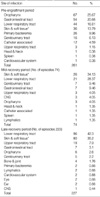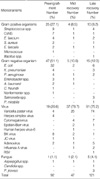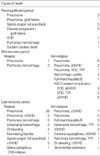1. Gratwohl A, Schmid O, Baldomero H, Horisberger B, Urbano-Ispizua A. Hematopoietic stem cell transplantation (HSCT) in Europe 2002. Changes in indication and impact of team density. A report of the EBMT activity survey. Bone Marrow Transplant. 2004. 34:855–875.
2. Helen LL, Pharm B, Wingard JR. Infections following hematopoietic stem cell transplantation. Infect Dis Clin N Am. 2001. 15:483–520.
3. Einsele H, Bertz H, Beyer J, Kiehl MG, Runde V, Kolb HJ, Holler E, Beck R, Schwerdfeger R, Schumacher U, Hebart H, Martin H, Kienast J, Ullmann AJ, Maschmeyer G, Kroger W, Niederwieser D, Link H, Schmidt CA, Oettle H, Klingebiel T. Infectious complications after allogeneic stem cell transplantation: epidemiology and interventional therapy strategies. Ann Hematol. 2003. 82:S175–S185.

4. Park SH, Choi SM, Lee DG, Choi JH, Yoo JH, Shin WS, Min WS, Kim CC. Infectious complications following HSCT: experience of 20 years (1983-2002) in Cathtolic HSCT Center. Korean J Med. 2004. 67:Suppl 1. S142.
5. Hughes WT, Armstrong D, Bodey GP, Bow EJ, Brown AE, Calandra T, Feld R, Pizzo PA, Rolston KV, Shenep JL, Young LS. 2002 guidelines for the use of antimicrobial agents in neutropenic patients with cancer. Clin Infect Dis. 2002. 34:730–751.

6. Ascioglu S, Rex JH, de Pauw B, Bennett JE, Bille J, Crokaert F, Denning DW, Donnelly JP, Edwards JE, Erjavec Z, Fiere D, Lortholary O, Maertens J, Meis JF, Patterson TF, Ritter J, Selleslag D, Shah PM, Stevens DA, Walsh TJ. Defining opportunistic invasive fungal infections in immunocompromised patients with cancer and hematopoietic stem cell transplants: an international consensus. Clin Infect Dis. 2002. 34:7–14.

7. Ljungman P, Griffiths P, Paya C. Definitions of cytomegalovirus infection and disease in transplant recipients. Clin Infect Dis. 2002. 34:1094–1097.

8. Glucksberg H, Storb R, Fefer A, Buckner CD, Neiman PE, Clift RA, Lerner KG, Thomas ED. Clinical manifestations of graft-versus-host disease in human recipients of marrow from HL-A-matched sibling donors. Transplantation. 1974. 18:295–304.

9. Shulman HM, Sullivan KM, Weiden PL, McDonald GB, Striker GE, Sale GE, Hackman R, Tsoi MS, Storb R, Thomas ED. Chronic graft-versus-host syndrome in man. A long-term clinicopathologic study of 20 Seattle patients. Am J Med. 1980. 69:204–217.
10. Choi SM, Lee DG, Choi JH, Yoo JH, Kim YJ, Park SH, Park SN, Min CK, Lee S, Kim HJ, Kim DW, Lee JW, Min WS, Shin WS, Kim CC. Risk-adapted preemptive therapy for cytomegalovirus disease after allogeneic stem cell transplantation: a single-center experience in Korea. Int J Hematol. 2005. 81:69–74.

11. Shin WS, Choi JH, Yoo JH, Kim HJ, Min CK, Eom HS, Cho B, Kim DW, Lee JW, Han CW, Han KJ, Hong YS, Min WS, Choi IB, Han H, Kim HK, Kim CC, Kim WI, Kim DJ. Infectious complications after bone marrow transplantation-experience of Catholic hematopoi etic stem cell transplantation center-from 1993 to 1996. Korean J Hematopoietic Stem Cell Transplant. 1998. 3:87–98.
12. Lee DG, Choi SM, Choi JH, Yoo JH, Shin WS, Kim CC. Infectious complications following hematopoietic stem cell transplantation in a single institution in Korea (1998-1999). Abstr. 29th World Congress of the International Society of Hematology. Seoul, Korea, 24-28, August, 2002. Int J Hematol. 2002. 76:Suppl 1. 184.
13. Yoo JH, Lee DG, Choi SM, Choi JH, Park YH, Kim YJ, Kim HJ, Lee S, Kim DW, Min WS, Shin WS, Min WS, Kim CC. Infectious complications and outcomes after allogeneic hematopoietic stem cell transplantation in Korea. Bone Marrow Transplant. 2004. 34:497–504.

14. Collin BA, Leather HL, Wingard JR, Ramphal R. Evolution, incidence, and susceptibility of bacterial bloodstream isolates from 519 bone marrow transplant patients. Clin Infect Dis. 2001. 33:947–953.

15. Yoo JH, Huh DH, Choi JH, Shin WS, Kang MW, Kim CC, Kim DJ. Molecular epidmiological analysis of quinolone-resistant Escherichia coli causing bacteremia in neutropenic patients with leukemia in Korea. Clin Infect Dis. 1997. 25:1385–1391.
16. Lee DG, Choi SM, Cho JH, Yoo JH, Park YH, Kim YJ, Lee S, Min CK, Kim HJ, Lee JW, Min WS, Shin WS, Kim CC. Selective bowel decontamination for the prevention of infection in acute myelogenous leukemia: a prospective randomized trial. Korean J Intern Med. 2002. 17:38–44.
17. Reuter S, Kern WV, Sigge A, Döhner H, Marre R, Kern P, Baum H. Impact of fluoroquinolone prophylaxis on reduced infection-related mortality among patients with neutropenia and hematologic malignancies. Clin Infect Dis. 2005. 40:1087–1093.

18. Gomez L, Garau J, Estrada C, Marquez M, Dalmau D, Xercavins M, Marti JM, Estany C. Ciprofloxacin prophylaxis in patients with acute leukemia and granulocytopenia in an area with a high prevalence of ciprofloxacin-resistant Escherichia coli. Cancer. 2003. 97:419–424.
19. Choi SM, Lee DG, Kim MS, Kim DY, Park YH, Kim YJ, Kim HJ, Lee S, Choi JH, Yoo JH, Kim DW, Lee JW, Min WS, Shin WS, Kim CC. Clinical features and risk factors of the septic shock in patients with neutropenic fever. Infect Chemother. 2003. 35:370–376.
20. Jaffe D, Jakubowski A, Sepkowitz K, Sebti R, Kiehn TE, Pamer E, Papanicolaou GA. Prevention of peritransplantation viridans streptococcal bacteremia with early vancomycin administration: A single-center observational cohort study. Clin Infect Dis. 2004. 39:1625–1632.

21. Boeckh M, Leisenring W, Riddell SR, Bowden RA, Huang ML, Myerson D, Stevens-Ayers T, Flowers ME, Cunningham T, Corey L. Late cytomegalovirus disease and mortality in recipients of allogeneic hematopoietic stem cell transplants: importance of viral load and T-cell immunity. Blood. 2003. 101:407–414.

22. Ju JH, Choi JH, Lee DG, Baek JY, Koh YH, Lee HJ, Kim SH, Shin HJ, Kim YJ, Park YH, Park CY, Shin WS, Kim CC. Pneumocystis carinii pneumonia following stem cell transplantation. Korean J Infect Dis. 2001. 33:273–279.
23. Dykewicz CA. Summary of the guidelines for preventing opportunistic infections among hematopoietic stem cell transplant recipients. Clin Infect Dis. 2001. 33:139–144.

24. Castagnola E, Dini G, Lanino E, Tasso L, Dallorso S, Garaventa A, Rossi GA, Giacchino R. Low CD4 count in a patient with P. carinii pneumonia after autologous bone marrow transplantation. Bone Marrow Transplant. 1995. 15:977–978.
25. Marr KA, Carter RA, Boeckh M, Martin P, Corey L. Invasive aspergillosis in allogeneic stem cell transplant recipients: changes in epidemiology and risk factors. Blood. 2002. 100:4358–4366.

26. Singh N, Paterson DL. Aspergillus infections in transplant recipients. Clin Microbiol Rev. 2005. 18:44–69.

27. In : Almyroudis S, Jaffe D, Sepkowitz KA, Pamer EG, Meier EN, Papadophoulos E, Small TN, Papanicolaou GA, editors. Risk factors for late invasive aspergillosis (IA) after allogeneic stem cell transplantation, abstr. 43rd Intersci. Conf. Antimicrob Agents Chemother; 14-17 September 2003; Chicago, Ill.. –M-1006, Abstr.
28. Wingard JR. Antifungal chemoprophylaxis after blood and marrow transplantation. Clin Infect Dis. 2002. 34:1386–1390.

29. Mennink-Kersten MA, Donnelly JP, Verweij PE. Detection of circulating galactomannan for the diagnosis and management of invasive aspergillosis. Lancet Infect Dis. 2004. 4:349–357.

30. Yoo JH, Choi JH, Choi SM, Lee DG, Shin WS, Min WS, Kim CC. Application of nucleic acid sequence-based amplification for diagnosis of and monitoring the clinical course of invasive aspergillosis in patients with hematologic diseases. Clin Infect Dis. 2005. 40:392–398.






 PDF
PDF ePub
ePub Citation
Citation Print
Print








 XML Download
XML Download